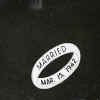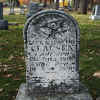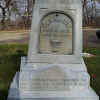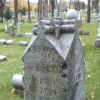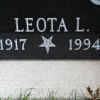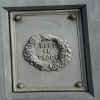|
ENDNOTES
1. "Cemetery Symbolism: A Wary Glossary", Cities of the Silent
Website,
<http://www.best.com/~gazissax/silence/symbols/symbols1.html>.
2. Elwood W. Post, Saints Signs and Symbols (New York: Morehouse Barlow
Company, 1962), 73.
3. Cities of the Silent Website, 1.
4. John Gary Brown, Soul in the Stone: Cemetery Art From America's
Heartland
(Lawrence: University of Kansas Press, 1994), 53.
5. Cities of the Silent Website, 2.
6. Thomas Albert Stafford, Christian Symbolism in Evangelical
Churches (New York:
Abington-Cokesbury Press, 1942), 143.
7. Stafford, 65.
8. Stafford, 89.
9. Stafford, 122.
10. Francis V. Duvall and Ivan B. Rigby, Early American Gravestone Art in
Photographs
(New York: Doves Publications, Inc.,
1978), 132;
Post,19.
11. Cities of the Silent Website, 5.
12. Post, 23.
13. Brown, 53.
14. Cities of the Silent Website, 3.
15. Cities of the Silent Website, 3.
16. "Albrecht Durer," Artchives Website, (http://www.artchive.com).
17. Stafford, 58.
18. Cities of the Silent Website, 3.
19. Cities of the Silent Website, 3.
20. Duvall, 132.
21. Duvall, 132.
22. Cities of the Silent Website, 4.
23. Cities of the Silent Website, 5.
24. G. Walker Jacobs, Stranger Stop and Cast Your Eye: A Guide to Gravestones
and Grave Rubbings (Brattleoboro, Vermont: Stephen Careen
Press, 1973), 26.
25. Post, 64.
26. Stafford, 50.
27. "Free Masonry," The Encyclopedia Britannica, vol. 4.
Chicago, 1988,
966.
28. Jacobs, 26.
29. Duvall, 132.
BIBLIOGRAPHY
"Albrecht Durer." Artchives Website. http://www.artchives.com
"A Wary Glossary of Cemetery art." Cities of the Silent Website.
http://www.best.com/~gazissax/silence/symbols/symbols1.html.
Brown, John Gary. Soul in the Stone: Cemetery Art from America’s Heartland.
Lawrence:
University of Kansas Press, 1994
Duvall, Francis V. and Ivan B. Rigby. Early American Gravestone Art in Photographs.
New York: Doves Publications, Inc., 1978.
Jacobs, G. Walker. Stranger Stop and Cast Your Eye: A Guide to Gravestones and
Grave Rubbings. Brattleboro, Vermont: Stephen Cereen
Press, 1973.
Post, W. Elwood. Saints, Signs, and Symbols. New York: Morehouse-Barlow Company,
1962.
Stafford, Thomas Albert. Christian Symbolism in the Evangelical Churches.
New York:
Abington-Cokesbury Press, 1942.
|
